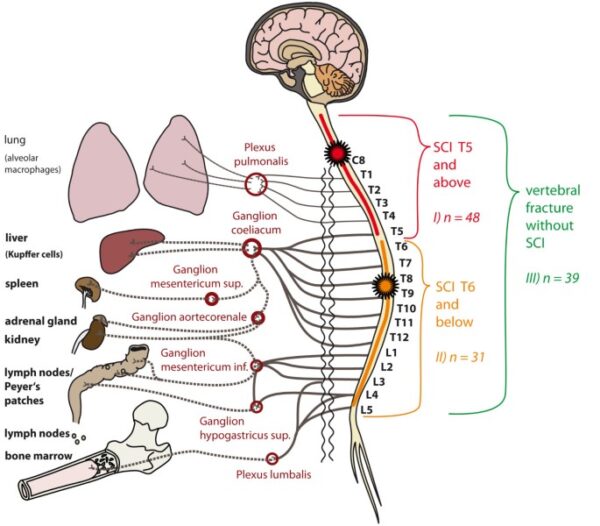Contents
- 1 New Discoveries Shed Light on How Immune System Detects and Repairs Spinal Cord Injuries
- 2 Introduction to Spinal Cord Injuries
- 3 How the Immune System Detects and Repairs Spinal Cord Injuries
- 4 Different Types of Spinal Cord Injuries
- 5 The Role of the Immune System in Repairing Damage after a SCI
- 6 Potential Treatments for Spinal Cord Injury Based on These Findings
- 7 Conclusion
New Discoveries Shed Light on How Immune System Detects and Repairs Spinal Cord Injuries
New Discoveries Shed Light on How Immune System Detects and Repairs Spinal Cord Injuries:- The human body is an incredibly complex and intricate machine, capable of performing miraculous feats of healing and recovery. One area where this is particularly evident is in the way our immune system responds to spinal cord injuries. In recent years, researchers have made some exciting new discoveries that shed light on how our bodies detect and repair damage to the spinal cord. From cutting-edge therapies to groundbreaking insights into cellular processes, these findings are paving the way for a future where paralysis may no longer be a life sentence. Join us as we explore the latest breakthroughs in this fascinating field!
Introduction to Spinal Cord Injuries
A spinal cord injury (SCI) is a devastating event that can have a profound impact on an individual’s quality of life. The good news is that new discoveries are being made all the time about how the immune system can detect and repair SCIs.
In the past, the immune system played little to no role in SCI recovery. However, recent studies have shown that the immune system does in fact play a crucial role in SCI healing.
There are two main types of cells involved in SCI recovery: microglia and macrophages. Microglia are resident immune cells in the central nervous system (CNS) that become activated following an injury. They help to clear away debris and promote tissue repair. Macrophages are blood-borne immune cells that also become activated following an injury and help with tissue repair.
In a healthy individual, microglia and macrophages work together to efficiently repair damage caused by an injury. However, in people with SCI, this process is often impaired. This can lead to chronic inflammation and further damage to the CNS.
Recent discoveries about how the immune system responds to SCIs are providing new insight into potential treatments for this condition. For example, researchers have found that certain drugs can increase microglial activity and promote more effective tissue repair following an injury. Therapies that target specific molecules involved in the inflammatory response show promise for reducing chronic inflammation and promoting function.
How the Immune System Detects and Repairs Spinal Cord Injuries
The immune system is a complex network of cells and organs that work together to protect the body from infection and disease. The spinal cord is a vital part of the nervous system, and injuries to this area can cause paralysis or other serious problems.
Recent research has shed new light on how the immune system detects and repairs spinal cord injuries. Scientists have found that certain immune cells are attracted to the site of a spinal cord injury, where they help to repair damage and promote healing.
This is an exciting discovery, as it may lead to new treatments for spinal cord injuries that can improve recovery and quality of life for patients.
The immune system is the body’s natural defense against infection and disease. When the spinal cord is injured, the immune system is activated to repair the damage.
Recent research has shed light on how the immune system detects and repairs spinal cord injuries. Scientists have found that a type of white blood cell called a macrophage plays a key role in detecting and repairing damage to the spinal cord.
Macrophages are part of the innate immune system, which is the first line of defense against infection and injury. When the spinal cord is injured, macrophages are recruited to the site of injury where they clean up dead cells and debris. They also release signals that help stimulate the repair and regeneration of nerve cells.
Scientists believe that understanding how the immune system detects and repairs spinal cord injuries could lead to new treatments for this debilitating condition.
Different Types of Spinal Cord Injuries
There are many different types of spinal cord injuries that can occur. The most common type is a traumatic injury, which happens when the spine is damaged by a blow or other impact. Other types of spinal cord injuries include:
-Compressive injuries, which happen when the spine is compressed by pressure from the outside
-Degenerative injuries, which occur when the spine deteriorates over time
-Infectious injuries, which happen when the spine is infected by bacteria or viruses
-Tumor-related injuries, which happen when tumors press on the spine
The Role of the Immune System in Repairing Damage after a SCI
The immune system is a vital part of the body’s natural repair process after a spinal cord injury (SCI). New research is shed light on how the immune system detects and repairs damage to the spinal cord.
When the spinal cord is injured, the body’s natural repair mechanisms are activated. The immune system is one of the key players in this process. Immune cells are attracted to the site of injury and release substances that promote healing.
In addition to promoting healing, the immune system also helps to protect the injured area from further damage. This is done by forming a barrier around the injury site. This barrier keeps out harmful bacteria and other agents that could cause further damage.
The role of the immune system in repairing damage after a SCI is essential for a successful recovery. Without the help of the immune system, the body would be unable to properly heal itself after an injury.
Potential Treatments for Spinal Cord Injury Based on These Findings
There are a number of potential treatments for spinal cord injury that have been suggested based on these findings. One is to use drugs that target the immune system to improve the repair process. Another is to stimulate the regeneration of nerve cells.
A third potential treatment is to transplant healthy nerve cells into the injured area. This approach has shown promise in animal studies, but it is still in the early stages of research.
Whichever approach is ultimately used, it is clear that there is still much work to be done in this area. However, these findings represent an important step forward in our understanding of how the immune system responds to spinal cord injuries and paves the way for developing more effective treatments.
Conclusion
The new discoveries made by researchers have provided us with a better understanding of how the immune system detects and repairs spinal cord injuries. This research could potentially lead to more effective treatments for this debilitating type of injury, as well as further our knowledge on how the body responds to trauma. With such promising developments being made in the field, we can only hope that these discoveries will one day help those suffering from serious spinal cord injuries regain movement and mobility.
This new research on the immune system’s role in repairing spinal cord injuries is incredibly promising. Not only does it help to explain how our bodies are able to detect and repair these types of injuries, but also gives us a better understanding of what we can do to further aid the healing process. With this newfound knowledge, scientists can use it to develop more effective treatments for those suffering from spinal cord injury so that they can enjoy a higher quality of life.

